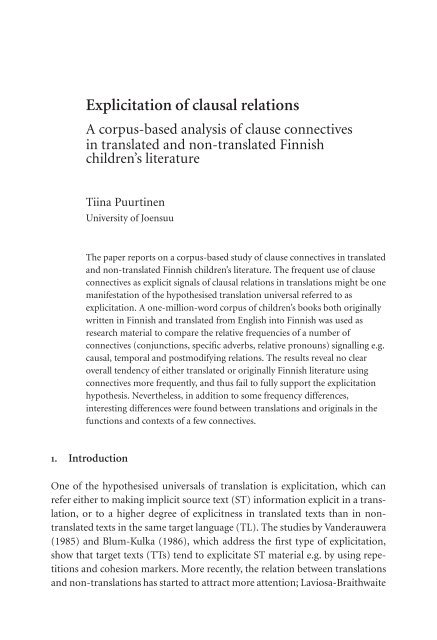Translation Universals.pdf - ymerleksi - home
Translation Universals.pdf - ymerleksi - home
Translation Universals.pdf - ymerleksi - home
You also want an ePaper? Increase the reach of your titles
YUMPU automatically turns print PDFs into web optimized ePapers that Google loves.
Explicitation of clausal relations<br />
Acorpus-basedanalysisofclauseconnectives<br />
in translated and non-translated Finnish<br />
children’s literature<br />
Tiina Puurtinen<br />
University of Joensuu<br />
The paper reports on a corpus-based study of clause connectives in translated<br />
and non-translated Finnish children’s literature. The frequent use of clause<br />
connectives as explicit signals of clausal relations in translations might be one<br />
manifestation of the hypothesised translation universal referred to as<br />
explicitation. A one-million-word corpus of children’s books both originally<br />
written in Finnish and translated from English into Finnish was used as<br />
research material to compare the relative frequencies of a number of<br />
connectives (conjunctions, specific adverbs, relative pronouns) signalling e.g.<br />
causal, temporal and postmodifying relations. The results reveal no clear<br />
overall tendency of either translated or originally Finnish literature using<br />
connectives more frequently, and thus fail to fully support the explicitation<br />
hypothesis. Nevertheless, in addition to some frequency differences,<br />
interesting differences were found between translations and originals in the<br />
functions and contexts of a few connectives.<br />
1. Introduction<br />
One of the hypothesised universals of translation is explicitation, which can<br />
refer either to making implicit source text (ST) information explicit in a translation,<br />
or to a higher degree of explicitness in translated texts than in nontranslated<br />
texts in the same target language (TL). The studies by Vanderauwera<br />
(1985) and Blum-Kulka (1986), which address the first type of explicitation,<br />
show that target texts (TTs) tend to explicitate ST material e.g. by using repetitions<br />
and cohesion markers. More recently, the relation between translations<br />
and non-translations has started to attract more attention; Laviosa-Braithwaite
















